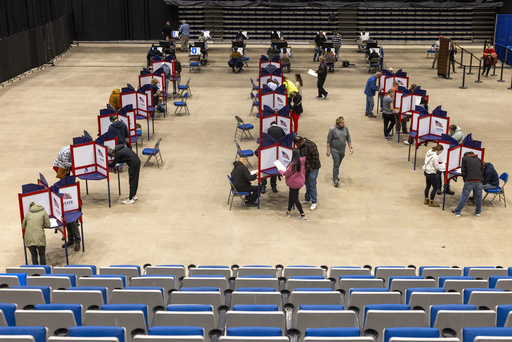
The 2024 presidential election exhibited extraordinary voter turnout, nearing the remarkable participation levels seen in the 2020 election, which challenges the traditional notion that Republicans find it difficult to win races with high engagement from the electorate.
Data compiled from the elections shows that over 152 million votes were cast in this contentious match-up between Republican candidate Donald Trump, who is now the president-elect, and Democratic contender Kamala Harris, the sitting vice president. Ballots are still being counted in states with slower reporting processes, such as California. Once the final counts are in, the total votes are anticipated to approach the 158 million cast during the record-breaking 2020 election, marking it as the highest voter turnout since women gained voting rights over a century ago.
Eitan Hersh, a political scientist from Tufts University, remarked, “Trump is excellent for driving voter turnout across both political parties.”
The former president’s successful bid, which leads both the popular and Electoral College votes — with Trump ahead by nearly 3 million votes nationwide — counters the prevailing belief that high-voter participation typically favors Democratic candidates. Trump’s concerns in 2020 about Democrats benefitting from expanded mail-in voting reflect his long-standing perspective, warning that such measures could jeopardize Republican election chances in the future. This skepticism grew amidst conspiracy theories surrounding mail voting during the pandemic, which Trump later claimed resulted in his 2020 defeat due to fraudulent activity.
The fallout from Trump’s assertions spurred a wave of new laws in GOP-controlled states imposing more stringent voting regulations, while Democratic-led states witnessed an expansion of mail voting opportunities. The dispute over voter turnout subsequently became a central issue in political discussions. These regulations often had negligible impacts on voting behavior, but they fueled mutual accusations of voter suppression by Democrats and claims of electoral fraud by Republicans.
“It’s quite an embarrassing narrative for both sides, given how evidently unfounded it is,” Hersh indicated.
Despite this ongoing battle over electoral logistics, Trump’s high-voter turnout triumph may alleviate some of the pressure surrounding this issue.
Patrick Ruffini, a Republican data analyst, noted, “Now that you’ve won the popular vote, things might quiet down.” He has long maintained that the Republican Party can thrive in elections with more extensive voter turnout and a diverse voter base.
Analysts observed that voter turnout in pivotal swing states was even more robust compared to the national average.
“This election was particularly centered around seven states compared to previous contests,” Ruffini explained.
While the wider country demonstrated a distinct shift from the 2020 results, when Democrat Joe Biden won the popular vote by a margin of 7 million votes, the results in critical swing states were closer. In noncompetitive states, like Illinois, there were significant dips in voter turnout with over 500,000 fewer votes compared to the last election, while Ohio saw a decrease of over 300,000 votes.
On the contrary, battlegrounds such as Georgia, Michigan, Nevada, North Carolina, Pennsylvania, and Wisconsin noted an increase in voting participation, all of which were states won by Trump. Arizona’s turnout remained almost on par with that of four years prior, as the state was still in the ballot-counting process.
Notably, Harris matched or exceeded Biden’s vote counts in Georgia, Nevada, North Carolina, and Wisconsin, with a turnout that far surpassed that of the 2016 election, where 135.6 million ballots were cast in the competition won by Trump against Democrat Hillary Clinton. However, the issue for Democrats lies in the fact that Trump performed better in these battleground areas compared to his previous election.
“The Harris team effectively engaged voters who might not have otherwise turned out, but Trump still mobilized more,” stated Tom Bonier, a Democratic data analyst.
Among those new Trump supporters was 26-year-old Jasmine Perez, who expressed her alignment with Trump’s endorsement of Christian values.
“I’m a Christian, and he aligns well with my beliefs as a Christian in America,” Perez shared.
Diego Zubek, 27, another voter who had previously supported Trump in 2016 but abstained from voting in the following election, made it clear he was determined to participate this time around.
“I couldn’t let that happen again,” Zubek asserted.
The GOP’s strategic push aimed at attracting voters like Perez and Zubek involved encouraging early and mail-in voting—a shift from previous elections where such voters were largely ignored due to Trump’s assertions about voting fraud. The party launched comprehensive voter registration campaigns and initiatives designed to boost turnout among those less likely to engage, an area traditionally overlooked by GOP operatives.
Data indicates that over half of the votes in this year’s election were cast prior to Election Day, according to tracking of advanced votes.
Throughout the campaign, Andrew Kolvet, a representative for Turning Point Action—a conservative organization spearheading a voter mobilization effort with a robust workforce across various battleground states—cited Stacey Abrams, a former Democratic candidate for Georgia governor, as a key influencer. Abrams’ ability to galvanize Black voters and other demographics in her state contributed significantly to Biden’s victory in Georgia during the last election.
“We recognized that Trump has a tremendous pool of low-propensity conservatives who simply needed a little encouragement,” Kolvet mentioned in a recent interview. “They felt their vote wouldn’t matter, and many were unclear on the voting process.”
Kolvet acknowledged the historic perspective among conservatives that large voter turnout detrimental to their chances; however, he argued this view has evolved within the Trump era: “Our ideas resonate more with the public now,” he claimed.
The future of this trend remains contingent on the forthcoming developments in Washington.
“It will hinge on whether conservatives can deliver on their campaign promises,” Kolvet concluded.
